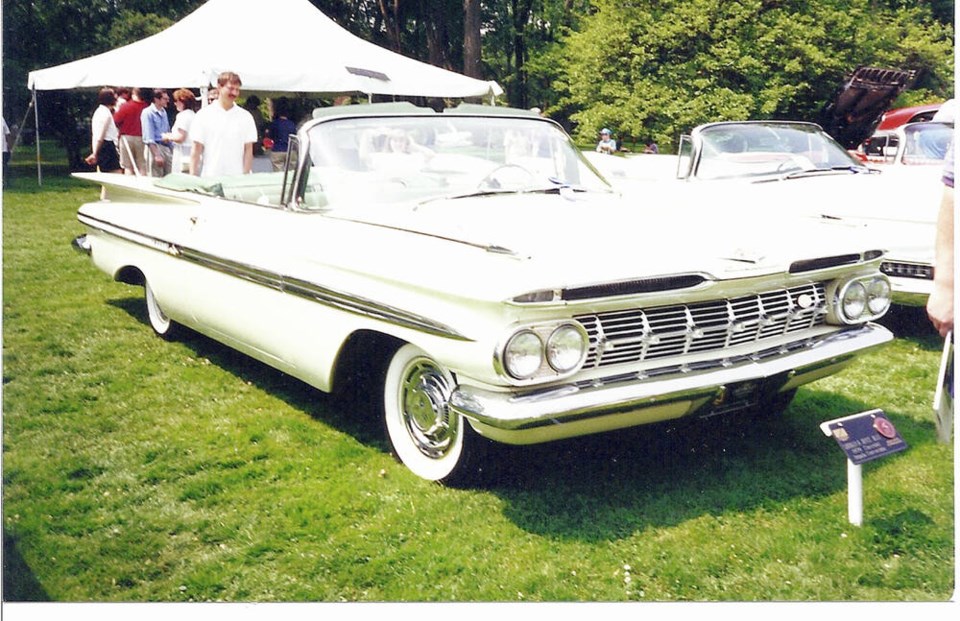In spite of tailfins being the American automobile styling rage in the 1950s, General Motors’ most popular car, the Chevrolet, didn’t adopt real fins until 1959.
Fins had originated in the late 1940s when they appeared as little more than raised taillights on the 1948 Cadillac. They came about because General Motors’ chief stylist Harley Earl wanted the rear of the car as well as the front to make a styling statement and the 1948 Cadillac taillights were the beginning of that theme.
Earl had become enamoured with the twin vertical tail-boom stabilizers on the P-39 Lockheed Lightening fighter planes he saw flying from Selfridge Air Base north of Detroit. They became his inspiration for Cadillac’s fins.
After some initial resistance the public embraced tailfins and they became a Cadillac hallmark. Since General Motors then set the styling trend virtually all manufacturers adopted them. Even conservative Mercedes-Benz, would eventually adopt a modest fin treatment.
Fins rose through the decade, reaching their zenith in the late 1950s. Chrysler Corp. introduced huge, soaring tailfins in its 1957 models, the final departure from the conservative tack it took with the new post-Second World War 1949 models. Those fins temporarily wrestled styling leadership away from GM. Cadillac soon recovered it.
Chevrolet, aware of its somewhat conservative middle class clientele, was a little more reluctant to enter the fin wars. It added small points to the rear fenders of its 1957 models and in 1958 introduced an all-new rounded and tastefully attractive but finless design. Sales suffered in a short, sharp economic recession, but the 1958 “fold over” rear fenders provided a hint of what was to come the following year.
Nineteen-fifty-nine was the year General Motors decided to show the world what fins were really all about. Cadillac arrived with towering lethal looking daggers, Buck got delta wings and Pontiac had twin-blade appendages. Only Oldsmobile with rather nondescript lumps on the rear fenders seemed out of step.
When Chevrolet finally broke out it did so in an unusual way. Among the wildest of all fins of 1959, right behind Cadillac’s in excess, were those on the Chevy. Variously described as “batwings” or “gull wings,” the horizontal fins truly spread like the wings of a bird.
They started just aft of the middle pillar, and grew wider until they culminated in a distinctly whale-like expanse extending over “cat’s eye” taillamps. These blades were accentuated by deeply sculpted rear quarter panels.
Unfounded rumours soon began circulating that these fins would cause the Chevy’s rear end to become light at high speeds and make the car unstable. Chevrolet vigorously denied this hearsay.
These were the years in which standard, popular priced cars were growing bigger. Chevrolet’s overall increase from 1957 to 1959 was 101.4 mm (4 in.) in wheelbase and 279 mm (11 in.) in overall length. Width reached its practical and legal, limit at 2,024 mm (79.7 in.). Window area was greatly increased by using a flatter roof and slimmer pillars.
The ’59 Chevrolet came in three series: entry level Biscayne, intermediate Bel Air and the top-of-the-line Impala which had debuted as the Bel Air option on the ’58 models and was broken out as a separate series in ’59.
There were also the Brookwood, Parkwood and Nomad station wagons. Chevrolet had a full line of body types including the handsome four-door pillarless “Sport Sedan.”
There were three engine choices: the trusty 3.8. litre (235 cu in.) overhead valve inline six, and 4.6 litre (283 cu in.) and 5.7 litre (348 cu in.) V-8s in various states of tune and horsepower.
With transmissions of three- and four-speeds (this available with high performance engines), plus overdrive, two-speed automatic and other options, the scope for creating a tailor-made Chevrolet was almost limitless.
The star-crossed “Level Air” air suspension of 1958 was still offered, although it had proved troublesome. Few were ordered by wary buyers and it was soon discontinued.
There was also a sedan delivery version and the newly introduced El Camino sedan pickup, Chevrolet’s response to the Ford Ranchero that had arrived in 1957.
In keeping with GM’s body-sharing policy which dictated that different corporate nameplates share their body architecture, the ’59 Chevy’s basic inner sheetmetal was common to Pontiac, Oldsmobile and smaller Buicks.
Chevrolet moved into 1960 with a more conservative look reflecting society’s moderating tastes. The ’60 Chevy fins were toned down and bent flat, and the “cat’s eye” taillamps were replaced with round ones. The ’59’s “nostrils” above the grille also disappeared.
Chevrolet had probably been wise to resist fins as long as it did because they proved to be little more than a styling gimmick that would soon disappear. Chevrolet discontinued them altogether for 1961 and fins faded out completely as the decade progressed.



